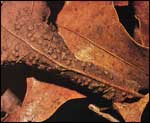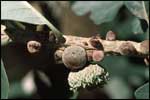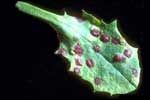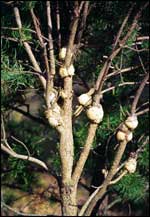Plant Galls
An intriguing world of plant galls is all around us, but many individuals probably have never seen a gall or known what it was if it was noticed. The gall is an example of a plant-animal relationship, but the plant is an unwilling and helpless partner. More than 2,000 types of beetles, moths, aphids, flies, and wasps, as well as mites (not insects), nematodes (parasitic worms), fungi, and bacteria can cause abnormal plant growths. They may be found on any part of a plant—buds, leaves, flowers, twigs, under the bark, and even on the roots.

Insect galls vary in size from about two inches to less than one-sixteenth of an inch in diameter. Some are little more than slightly thickened areas on leaves. They come in almost any shape—perfectly round, oblong, egg-shaped, spindle-shaped, bottle-shaped, or obviously abnormal, ugly, cancerlike growths. Some look like pine cones, but they form on the willow and are caused by a gall fly. Others, such as those formed on the cypress by a tiny gall gnat, resemble flowers and could be mistaken for small yellowish blossoms. Gall gnats also may produce structures on leaves that look like buttons, tiny duncecaps, or pointed tubes or columns. The spiney rose gall, caused by a gall wasp, is round, but its surface is covered with sharp spines in pastel shades of pink and yellow.
Beautiful or ugly, large or small, the gall is completely made up plant tissue, but it is the insect and its particular chemicals that control the form and shape of the gall. Usually the adult female of the gall-making creature selects a plant during the spring or early summer while the plant is still actively growing and inserts her ovipositor (egg-laying organ) into a tender growing part. When she deposits her egg or eggs, she also injects a chemical that causes the gall to begin forming. When the egg hatches, the larva continues to release a chemical that keeps the gall growing to match the size of the larva.
Little is known about the chemical nature of the gall-producing secretion, but it is a complex substance rich in nucleic acid and protein. Nucleic acid is the substance that passes hereditary characteristics from one generation to the next and influences growth. Since irregular cell division occurs in both plant galls and cancerous growths in animals, there are some researchers who believe there may be a close relationship between the chemicals found in the two.

Some insects can cause plants to form plant-tissue homes for their eggs and young. These homes, called galls, may look quite different – fuzzy clumps or hard balls on leaves and stems, or growths with tightly closed slits that open to allow the hatched insects to emerge.
Selection of the plant for egg laying by gall makers is not always limited to a specific type of plant, but some do show preferences. If one species of insect selects several different kinds of plants in which to lay its eggs, each plant will produce very similar galls. However, if several different species of gall makers select the same plant, they will cause it to produce galls that are quite different from each other.
There are two main types of galls—closed and open. Insects such as wasps, moths, and flies, which have chewing mouthparts in their adult or larval stages, are usually found in completely closed galls. When the time arrives to emerge, the adult chews its way out or exits through an opening made by the larval stage. Insects with sucking mouthparts must use partially open galls or galls that open for them when it is time to emerge. The aphid is one of the latter type. Its marble-sized gall forms on the leaf stem of the cottonwood tree. The gall is thin-walled, but within its structure a whole colony of aphids develops. At the proper time, a slit appears on one side of the gall, and the lips of the slit open to allow the aphids to escape.
In addition to the growth-stimulating chemicals, many insects produce an enzyme that changes the plant's starch into sugar, causing some of the galls to accumulate large amounts of it. Scrub oak and shin oak galls found in the Southwest contain so much sugar that it oozes out in liquid form onto their outer surfaces. This gall nectar or honeydew is gathered and stored by honey ants.

The honey ants, which are unable to make wax storage cells as bees do, use sterile female ants as living storage tanks to hold the honeydew to feed the rest of the ant colony during times when honeydew is not available. These females, which are fed to the bursting point by their fellow workers, are able to hold about eight times their weight in liquid honeydew in their elastic abdomens. Once they become too full to move, they hang themselves from the ceiling of the ant nest like small grape clusters, supported by tiny claws on their feet. When food is no longer available, a hungry worker approaches a storage-tank female, places its mouth against hers and a droplet of honeydew passes between them. In one section of California, the galls formed on oaks by a certain type of gall wasp produce so much honeydew that honeybees in the area gather it and may store as much as thirty or forty pounds of it in each hive.
Galls also contain large
amounts of tannic acid,
which is widely used in
the manufacture of medicines,
insecticides, and permanent
inks. The Aleppo oak gall
of Asia Minor, produced
by a cynipid wasp, contains
about 65 percent tannic
acid. For centuries the
best permanent inks were
made from these galls.

As far back as the ninth and tenth centuries, monks used inks made from a formula containing the tannic acid of the Aleppo gall to record their manuscripts. The United States Treasury, the Bank of England, and some foreign governments also have specified that permanent inks produced from the Aleppo galls be used when printing their money and when writing important documents. However, synthetic chemicals have largely replaced galls in the manufacture of inks for most purposes. Extracts from galls also have been used throughout the world for making dyes. A scarlet dye called Turkey red is obtained from the "mad apple" gall and is widely used in Asia Minor in the dyeing of rugs and fabrics.
Although they are rich in nutritional value, the high tannic acid content of the galls makes them unsuitable for humans to eat; however, in Missouri and Arkansas a particular species of oak gall falls from the trees in the autumn and is gathered for livestock feed.
Most gall makers are harmless
to the plant hosts except
for deforming them and spoiling
their appearance, and many
galls are useful. However,
there are some gall makers
that are considered serious
pests to farmers. One of
these is the larval stage
of a gall fl known as the
wheat jointworm. It attacks
the wheat stems, forming
galls and reducing the wheat
yield. Others are the clover
leaf midge, which attacks
the clover blossoms in such
numbers as to prevent seed
production, and a grape
aphid, which almost ruined
the French grape vineyards.

The grape aphid appeared in France around 1860, and during the next twenty-five years it destroyed more than 2 ½ million acres of grape vines. The first generation of this type of aphid covered the grape leaves with tiny galls that made the leaves yellow and wither, but the second generation attacked the roots, forming galls that caused the vines to rot. Since roots of American grapes were highly resistant to this destructive aphid, they were planted in French vineyards and the French grape varieties grafted to them. Since the quality of the fruit is determined by the characteristics of the leaf and stem system, the French grapes retained their own qualities and were not changed by the American root systems.
Whether useful or harmful, the gall insect has its own natural enemies to help keep its numbers under control. Since the gall is so obvious and unable to move, it is a sitting duck for any parasite or predator looking for a meal. Parasites of all types are able to penetrate the gall case and eat the defenseless larva inside. Predators such as birds, mice, and squirrels tear open the gall to reach the tasty insect or larva within, and there are some fishermen who use the larva found inside the goldenrod gall for fish bait. Other creatures known to scientists as inquilines (animals that live in the nests or abodes of other species) enter the gall to share the larva's food supply. These inquilines may take so much nourishment from the plant gall that the original gall resident dies of starvation.
Once the gall insect emerges naturally or becomes a meal for another creature, the empty gall still has its uses, as it provides a winder shelter for other insects. For example, the cavity in the goldenrod gall is used as a nursery by a certain type of wasp. This little wasp lays her egg in the gall, puts food in it, and plugs the old exit hole with a mud stopper.
Midges, aphids, plant bugs, flea beetles, springtails, thrips, mites and spiders often take refuge in willow pine cone galls. In fact, one study of such a gall revealed that there were thirty-one different species of insects within the gall—ten inquilines, sixteen parasites, and five transients (insects just passing through).
Empty or full, galls are interesting oddities of nature that should offer unlimited opportunities for investigation and discovery to the young naturalist. Fortunately, galls are easy to keep indoors. Just place some damp soil in a large-mouthed gallon jar and stick the stem with the gall on it into the dirt. Cover the top of the jar with cheesecloth or part of a nylon hose to prevent the escape of the insect when it emerges from the gall. Do not place the jar where it will receive direct sunlight or heat, and be sure the soil stays moist or the gall will dry out and the insect will die. If you collect more than one type of gall, place each different gall in a separate jar or you will not be able to tell which insect emerged from which gall. Good luck as you enter the world of plant galls.
Ilo
Hiller
1983 Plant Galls. Young
Naturalist. The Louise
Lindsey Merrick Texas Environment
Series, No. 6, pp. 86-89.
Texas A&M University
Press, College Station.